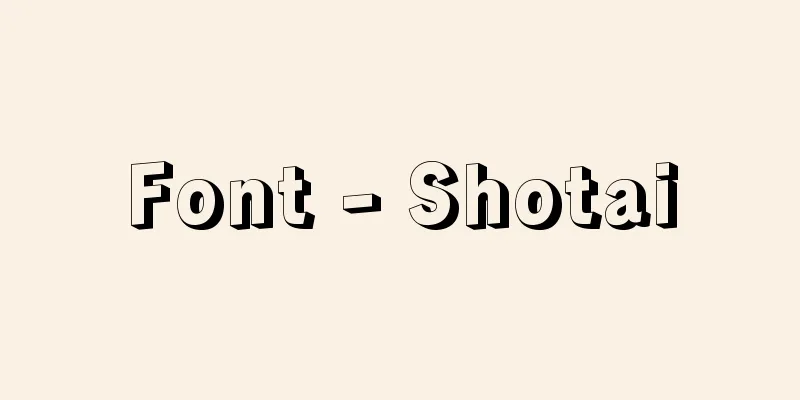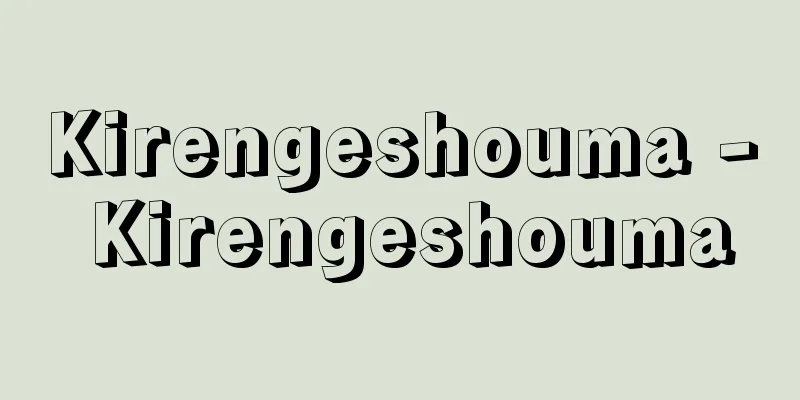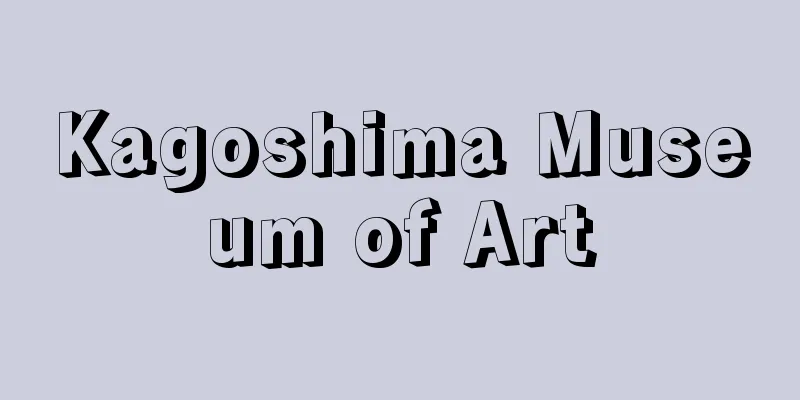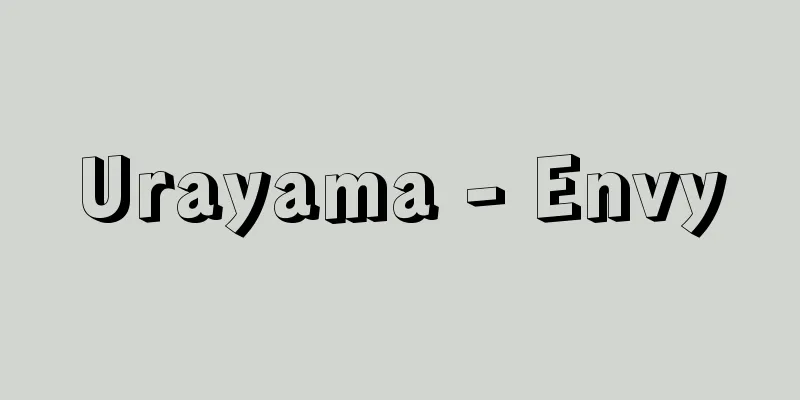Font - Shotai

|
In a broad sense, it refers to the form of expression of characters used in countries around the world, but in Japan it generally refers to the regular, running, and cursive forms of kanji and kana. It is said that something resembling writing first appeared during the Yellow River civilization in China, when the historian Cangjie (Soujie) created characters in the shapes of birds and tree branches during the reign of Emperor Yellow. However, these were still more like symbols than letters. Later, Yin script (carved with a sharp tool into tortoise shell or animal bones, also known as oracle bone script) appeared in the Yin dynasty, and Zhou script (written with a brush and carved into bells or tripods, also known as ancient bell and tripod script) appeared in the Zhou dynasty, and took on a form resembling writing. Furthermore, in the Eastern Zhou dynasty, stone drum script appeared, and this form of writing was used in the Daiten (large seal script) created by Shi Chu during the reign of King Xuan, so it is also called Daiten or Shu script. The small seal script was created by making the large seal script easier to copy and by making the dotted lines square, and is said to have been started by Li Si, the Prime Minister of Qin. During this period, Cheng Miao, who was accused by the First Emperor of China, created a character that further simplified the large seal script and the small seal script while in prison. This is called clerical script (ancient clerical script), and it can be said that this style of writing was established. Clerical script was the common script for a long time throughout the Former Han and Later Han dynasties, but during the Han dynasty it acquired a new decorative style, which was later called Han Rei or Happun to distinguish it from Korei, and today the term Clerical script usually refers to Happun. From Happun, Shi You created a new style of writing called Zhang Cao, which gradually evolved into the cursive script used today at the end of the Han dynasty. Furthermore, in the early part of the Later Han dynasty, Liu Desheng created running script, and towards the end of the same period, regular script was also born, and these three - regular, running, and cursive - became the basic styles of writing used today. These styles were introduced to Japan during the Nara period, and kana was created by simplifying the cursive style of Chinese characters. A typical kana style was created by Fujiwara no Yukinari during the Heian period, and later various improvements were made to it to create a style unique to Japan. There are also special style of writing such as Kanteiryu, used in Kabuki, Yose moji, Sumo moji, and designed special style of writing used in movable type, all of which are variations on existing styles. [Shigemi Komatsu] [Reference] | | |Source: Shogakukan Encyclopedia Nipponica About Encyclopedia Nipponica Information | Legend |
|
広義には世界各国で用いられる文字の表現形式をいうが、わが国では一般に漢字および仮名の楷(かい)、行(ぎょう)、草(そう)などの形態をいう。 文字らしいものが現れるのは中国の黄河文明期であり、黄帝の時代に史官蒼頡(そうきつ)が鳥や木の枝などをかたどって文字をつくったのが始まりといわれる。しかし、これらはまだ文字というよりも符号に近いものであった。その後、殷(いん)代に殷文(亀甲(きっこう)や獣骨に鋭い器具で刻んだもので甲骨文ともいう)、周代には周文(鐘や鼎(かなえ)に筆で書いて彫ったもので、鐘鼎(しょうてい)古文ともいう)が現れ、文字らしい体裁ができた。さらに東周代には、石に刻まれた石鼓(せっこ)文が現れるが、宣王の時代に史籀(しちゅう)がつくった『大篆(だいてん)』という字書にこの文字の形式が用いられたため、大篆とも籀文ともいわれる。この大篆を筆写に便利に、点描を方正にしたものが小篆であり、これは秦(しん)の丞相(じょうしょう)李斯(りし)が始めたと伝えている。ついでこの時代に、始皇帝の罪を得た程邈(ていばく)が、獄中で大篆および小篆をさらに簡略化した文字をつくった。これが隷書(れいしょ)(古隷)で、ここに書体はいちおう確立したということができる。 隷書は前漢・後漢(ごかん)を通じて長い間、通用文字になったが、漢代には新しい装飾的な波勢をつけたので、これを後世、漢隷または八分(はっぷん)といって古隷と区別し、今日では普通、隷書といえばこの八分をさす。この八分から史游(しゆう)によって章草という新しい書体がつくられ、これがしだいに進化して、漢代末期には現在用いられているような草書になったのである。 また、後漢の初期には劉徳昇(りゅうとくしょう)によって行書がつくられ、同じく末期には楷書も生まれ、この楷、行、草の三つが今日用いられている基本的な書体となった。これらの書体は奈良時代に日本に伝わったが、この漢字の草書体を簡略化してつくられたのが仮名である。仮名の書体は平安時代に藤原行成(ゆきなり)によってその典型的なものができ、のち種々の改良が加えられて、日本特有の書体が生まれた。また、歌舞伎(かぶき)に用いられる勘亭流をはじめ、寄席(よせ)文字、相撲(すもう)文字、さらに活字に用いられているデザイン化された特殊な書体がみられるが、いずれもいままでの書体に変化を加えたものである。 [小松茂美] [参照項目] | | |出典 小学館 日本大百科全書(ニッポニカ)日本大百科全書(ニッポニカ)について 情報 | 凡例 |
Recommend
Worth, Charles Frederick
Born: 1825. Lincolnshire [Died] March 10, 1895. Fo...
Offering tea - Kencha
There are two ways of thinking about offering tea...
Aurora
…He studied Kabbalah, alchemy, and theosophy on h...
Enciclopedia Italiana (English)
…In addition to gaining the consent of the people...
Hel Peninsula - Helhantou
Mierzeja Helska is a peninsula in the Gdansk Bay o...
Tridacna
…A general term for five species of bivalve shell...
Sonoki-so
A manor of the Kujo family located in Sonogi Count...
Irish Question
Britain, which had a hard time dealing with Irela...
Wang Futokufutang Monument
...The tomb of King George, the grandson of Kubla...
Fullmoon maple (English spelling)
…The Japanese maple and the large maple are also ...
Hokkaido Development - Hokkaido Development
It mainly refers to the social phenomenon of a lar...
Tomokichi Fukurai
Psychologist. Born in Gifu Prefecture. Studied at...
Hammarskjöld, Dag (Hjalmar Agne Carl)
Born: July 29, 1905, Jonkeping, Uppsala Died: Sept...
Apatosaurus - Apatosaurus (English spelling)
A herbivorous dinosaur found in the Late Jurassic...
Open and close
〘Noun〙 (also "kaigo") 1. To open and clo...





![Trio sonata (English spelling) [Italian]](/upload/images/67cc5da7822c1.webp)



